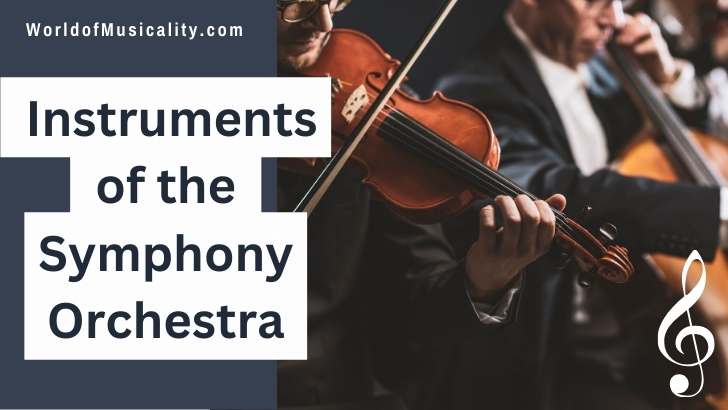
The instruments of the symphony orchestra form the backbone of the large ensemble of musicians that masterfully perform classical music.
Playing a pivotal role in the evolution of classical music, the symphony orchestra brings legendary composers such as Beethoven and Tchaikovsky and more modern film scores to audiences across the globe.
Consisting of four main sections: strings, woodwinds, brass, and percussion, each section of the orchestra adds a unique voice to create the unique, intricate and emotive music that define orchestral music.
In this article we explore the the diverse array of instruments used in symphony orchestras, grouping them by their family, along with a brief description of each.
String Instruments of the Orchestra
String instruments serve as the core of the symphony orchestra, often driving the harmonic and melodic foundations of the ensemble’s repertoire. With their wide range of dynamics and expressive capabilities, strings such as violins, cellos, and basses create the lush, resonant textures that are essential for the emotional depth and structural complexity of orchestral music.
Violin
The highest-pitched and most numerous string instrument in the orchestra, played with a bow to produce vibrant and expressive melodies.
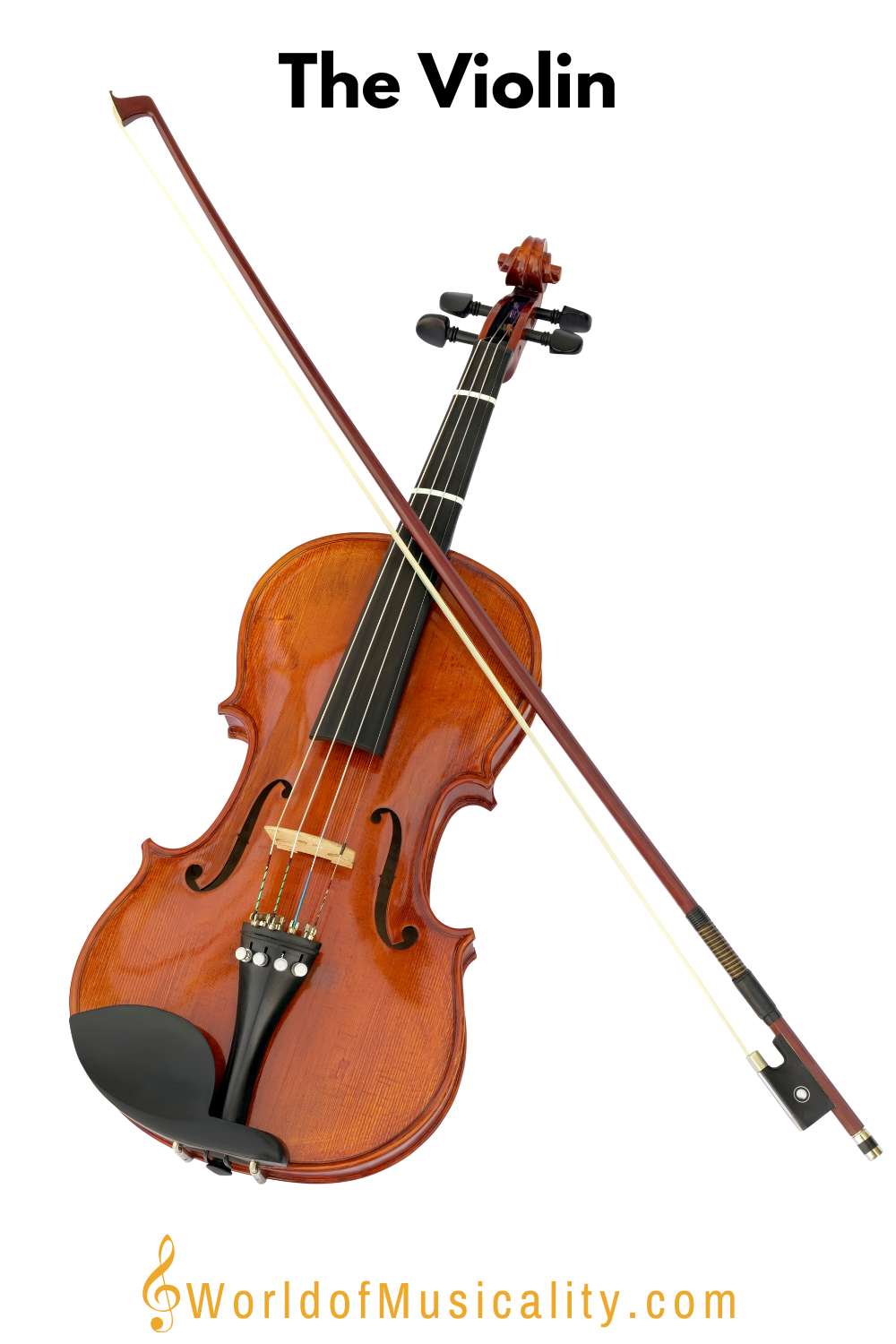
The violin is a stringed instrument known for its hourglass shape and the elegant curves of its wooden body, typically made from spruce for the top and maple for the back and sides. This design allows it to produce a bright and expressive sound that can convey a range of emotions, from joy to sorrow.
Played with a bow made of horsehair and wood, the violin emits its distinctive notes by the bow’s hair dragging across four tuned strings, creating vibration.
Originating in the 16th century in Italy, the violin quickly became a staple in orchestral compositions due to its versatility and powerful expressive capabilities. In a symphony orchestra, the violin is crucial, often carrying the melody and adding to the texture of the music.
It’s usually divided into two sections: first violins, which play higher-pitched melodies, and second violins, which support with harmony and rhythm.
Famous violinists like Niccolò Paganini and Itzhak Perlman have showcased the instrument’s vast potential, performing complex compositions that highlight the violin’s range and tonal beauty.
Viola
Slightly larger than the violin with a deeper, richer tone, the viola often plays counter-melodies or harmonizes with other strings.
The viola, similar in appearance to the violin but slightly larger, is a key string instrument in a symphony orchestra. Its body, traditionally crafted from maple and spruce, helps produce a warm, rich sound that is deeper than the violin due to its longer strings and larger body.
The sound of the viola is often described as mellow and resonant, making it perfect for carrying the middle harmonies in orchestral pieces, which adds depth to the music.
The viola’s origins trace back to the 16th century, evolving from earlier string instruments like the viol. In a symphony orchestra, the viola plays a crucial role by filling the gap between the violins and the lower-pitched cellos and double basses, often enriching the texture of the ensemble’s sound.
Notable composers who have showcased the viola in their works include Johann Sebastian Bach and Wolfgang Amadeus Mozart. A famous violist to note is William Primrose, whose performances and recordings have inspired many to appreciate the unique sound of the viola.
Cello
Known for its rich, warm tone, the cello produces a range of pitches and adds depth to the string section.
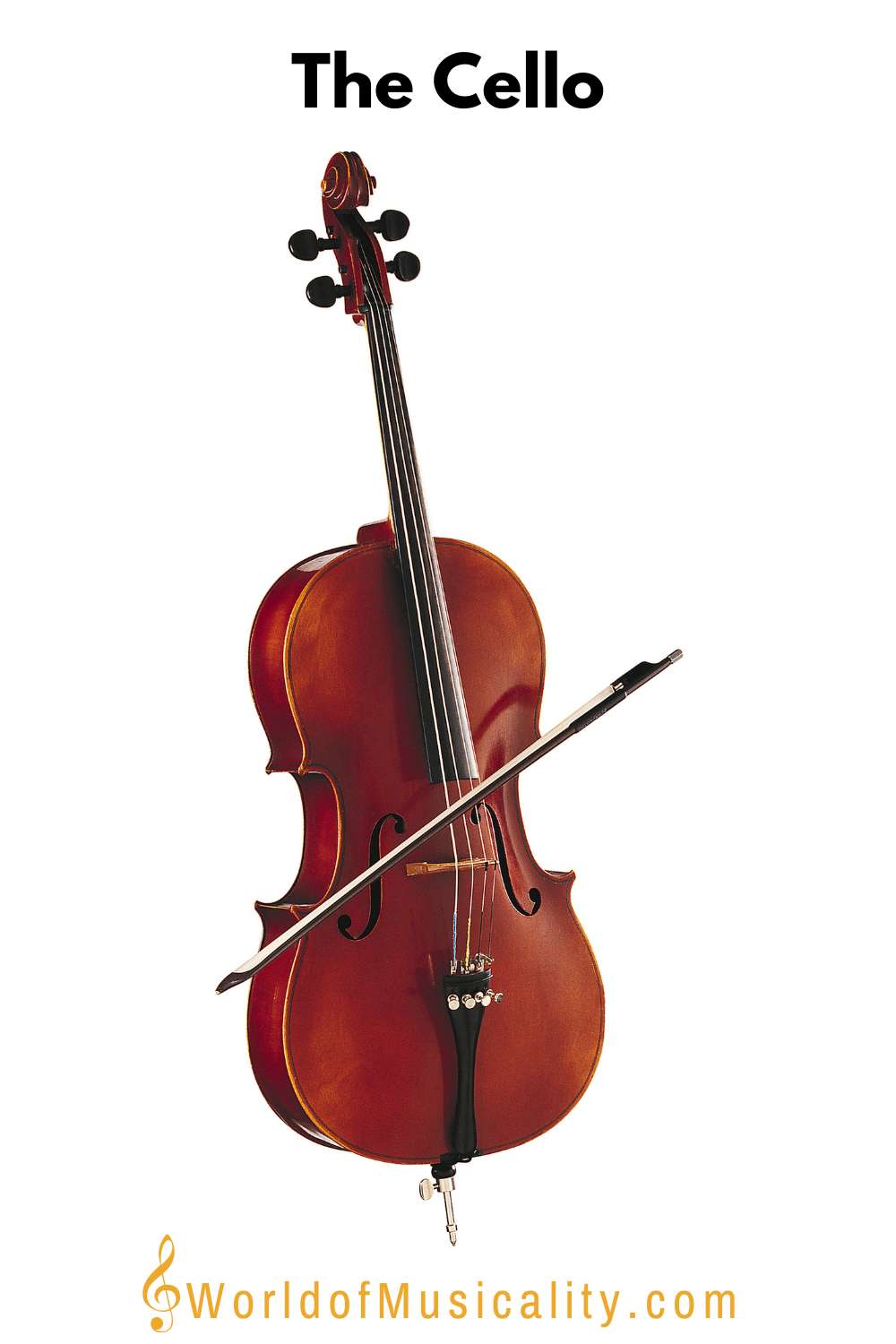
The cello, short for violoncello, is a large string instrument traditionally crafted from wood, with strings made of metal or gut. It is played upright, resting on the floor with a supporting peg, and musicians use a bow to draw sound from its strings. Physically, it has a resonant, hollow body, a long neck, and a curved bridge that supports the strings. The cello produces rich, deep tones that can convey a wide range of emotions, from sorrowful and soulful to bright and vigorous.
Originating in the 16th century in Italy, the cello has become a fundamental part of the symphony orchestra, typically serving as part of the backbone in the string section. It often plays harmony and supports the ensemble but can also take on beautiful, compelling solos.
Notable cellists to listen for include Yo-Yo Ma, a master of classical cello, and composers like Johann Sebastian Bach, whose Cello Suites are pivotal works in the instrument’s repertoire.
Double Bass
The largest and lowest-pitched string instrument, providing fundamental bass lines and rhythm.
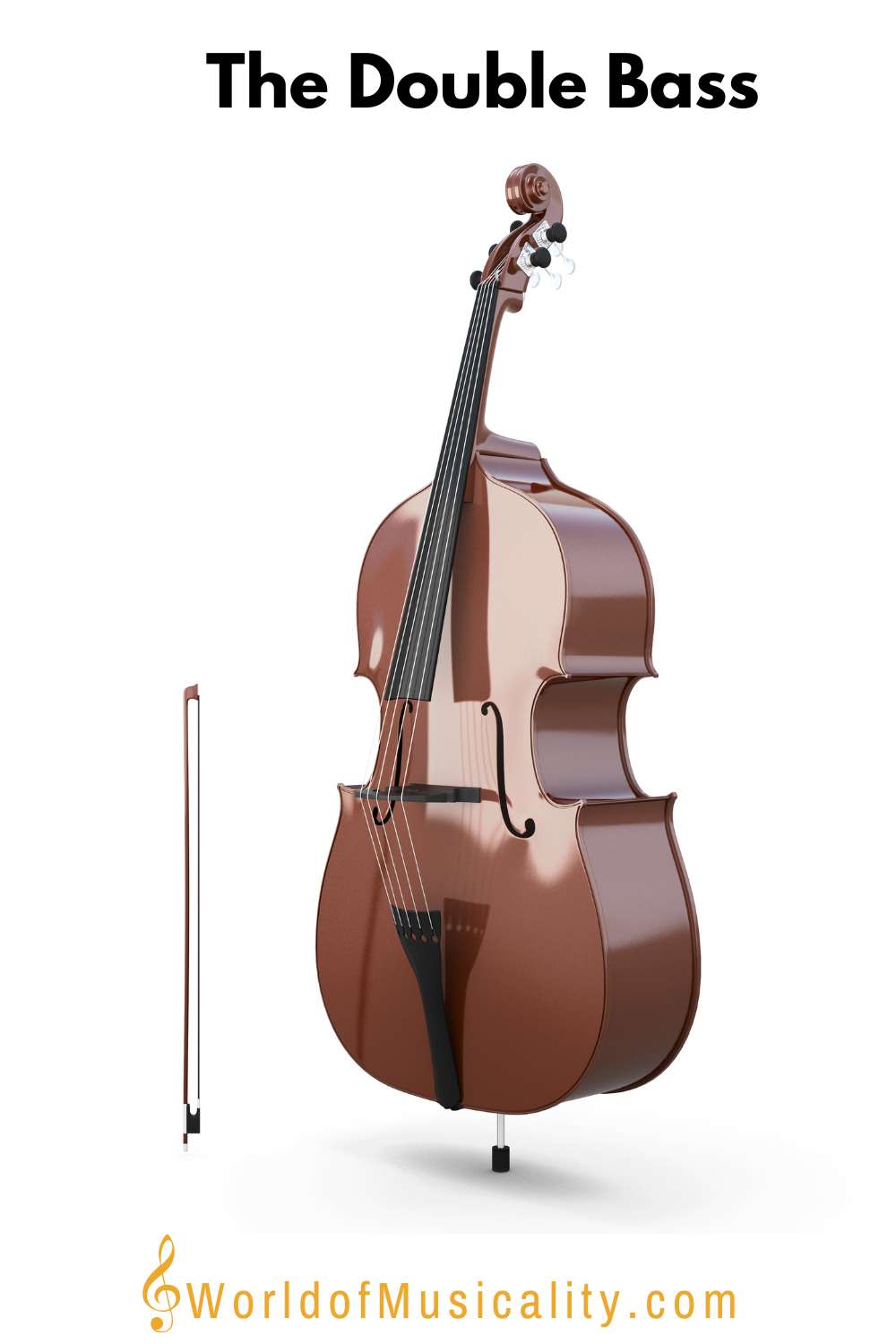
The double bass, also known as the contrabass, stands as the largest and lowest-pitched instrument in the string family. It is typically constructed from maple, spruce, and ebony, materials chosen for their ability to produce a resonant and rich sound.
Physically, the double bass has a large hollow body, a long neck, and strings that are plucked or bowed to create sound. Its deep, sonorous tones provide the foundation for the harmonic structure of the orchestra, anchoring the ensemble with its profound bass lines.
Originating in the early 16th century in Europe, the double bass has evolved significantly over the centuries. In a symphony orchestra, it plays a crucial role in balancing the sounds of other instruments, contributing to both rhythmic drive and harmonic depth.
Notable composers who have written extensively for the double bass include Giovanni Bottesini, known as the “Paganini of the double bass” for his virtuosic playing and compositions. Additionally, the works of Domenico Dragonetti are essential, as he was a pioneer in demonstrating the instrument’s capabilities.
The Pedal Harp
Played by plucking strings with the fingers, the pedal harp adds a distinctive, ethereal quality to the orchestra’s sound.
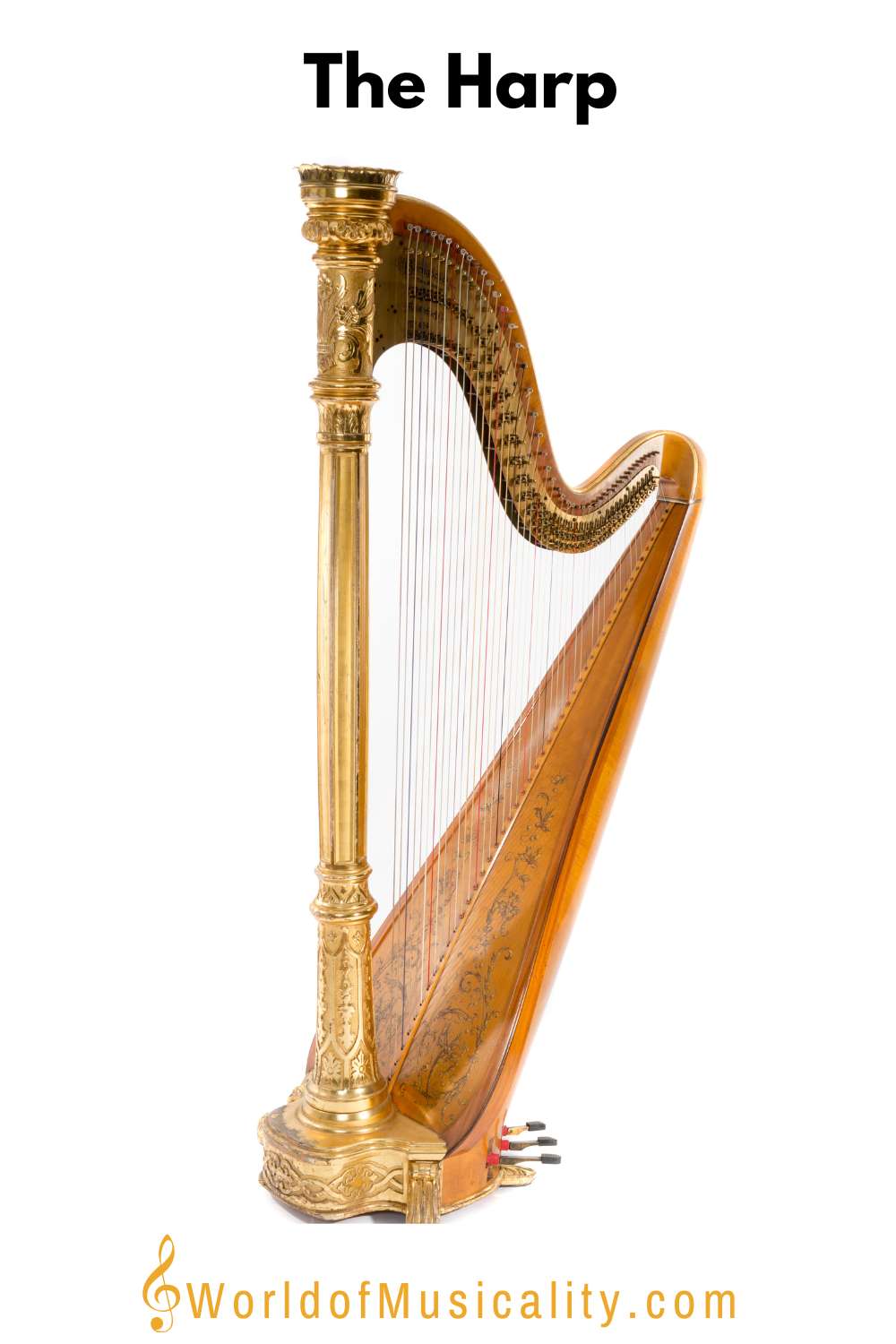
The Pedal harp is a large, elegantly shaped stringed instrument known for its angelic, resonant sound.
Typically, the pedal harp stands about five to six feet tall and features 47 strings stretched over a soundboard, with each string corresponding to a different musical note.
These strings are made from a variety of materials, including gut, nylon, and metal, which contribute to its distinct, shimmering sound. The harp’s frame and soundboard are usually crafted from wood, adding to its visual and tonal beauty.
Originating thousands of years ago, the harp has evolved significantly but always retained its status as a symbol of grace in music.
In a symphony orchestra, the harp provides a unique texture, often used to enhance soft, lyrical passages or to add a sparkling ambiance to the sound palette.
Prominent composers who have celebrated the harp in their compositions include Claude Debussy and Maurice Ravel. Debussy’s “Danses sacrée et profane” and Ravel’s “Introduction and Allegro” showcase the harp’s capabilities and are excellent pieces to experience its enchanting qualities.
Woodwind Instruments
The woodwind instruments of the symphony orchestra add a rich, versatile sound to the orchestra, capable of everything from bold sounds to delicate, intricate melodies.
Western Concert Flute
A high-pitched woodwind instrument producing a bright, clear sound; played by blowing across a hole at the top of the instrument.
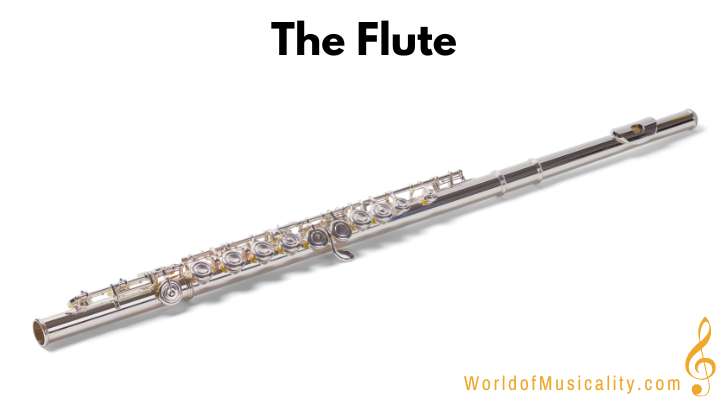
The orchestral flute is a sleek woodwind instrument predominantly made of metal—silver or gold, depending on the model. Known more accuratley as the Western concert flute its design consists of a long tube with holes that are covered by keys.
The player blows across the top opening, or embouchure hole, to create sound. This requires skilled lip shaping to control the pitch and tone.
The Western concert flute’s sound is clear and bright, often described as light and airy, making it easily recognizable.
It originated thousands of years ago, evolving from simple wood or bone flutes to the sophisticated metal versions used today.
In the symphony orchestra, the Western concert flute plays a vital role in carrying the melody, especially in higher registers where it excels at quick, intricate passages.
Significant figures associated with the flute include composers like Mozart, who adored its lyrical qualities, and virtuoso flutist James Galway, known for his expressive performances.
Oboe
Known for its penetrating, slightly nasal sound, the oboe plays melodious lines and is often used for solo passages.
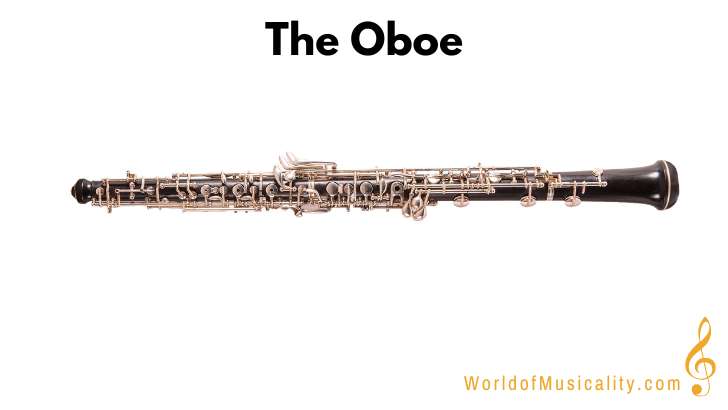
The oboe is a woodwind instrument, easily recognized by its slender, cylindrical shape and its use of a double reed, which vibrates to produce sound. Traditionally made from African Blackwood, the oboe is known for its clear, penetrating, and slightly nasal tone. The instrument is held vertically and played by blowing air through the reed, while fingers cover various holes and keys to change the pitch.
Originating from the mid-17th century, the oboe’s design has evolved from earlier instruments like the shawm.
In a symphony orchestra, the oboe often plays a leading role, carrying the melody or providing harmonious support with its expressive sound, capable of conveying a range of emotions from joy to sorrow.
Famous composers who have prominently featured the oboe in their works include Johann Sebastian Bach and Wolfgang Amadeus Mozart. A renowned oboist to also listen to is François Leleux, whose performances highlight the instrument’s capabilities and its unique sound.
Clarinet
Versatile and with a wide range of tones, the clarinet can produce both mellow and bright sounds.
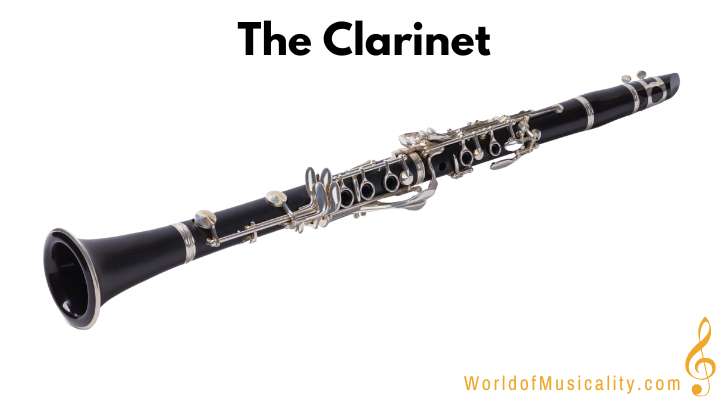
The clarinet is a woodwind instrument primarily made from African blackwood, also known as grenadilla, although some are made from plastic or other woods. It features a long cylindrical tube with a flared bell at one end and a mouthpiece fitted with a single reed at the other. Players produce sound by blowing air across the reed, causing it to vibrate. The clarinet is known for its warm, fluid tone, which can range from mellow and soothing to crisp and lively.
Originating in the early 18th century, the clarinet was developed by the German instrument maker Johann Christoph Denner. It quickly became a staple in orchestral compositions because of its versatility and wide range of pitch.
In the symphony orchestra, the clarinet plays a variety of roles, from carrying melodies to blending with other instruments for rich harmonies.
Notable clarinet composers include Wolfgang Amadeus Mozart, who was one of the first to write significant works for the clarinet, and Carl Maria von Weber, both of whom explored and expanded the capabilities of the clarinet. A famous clarinetist to listen for is Benny Goodman, known as the “King of Swing,” who brought the clarinet to prominence in jazz music as well as classical.
Bassoon
The lowest-pitched woodwind, offering a deep, rich sound crucial for adding depth to the woodwind section.
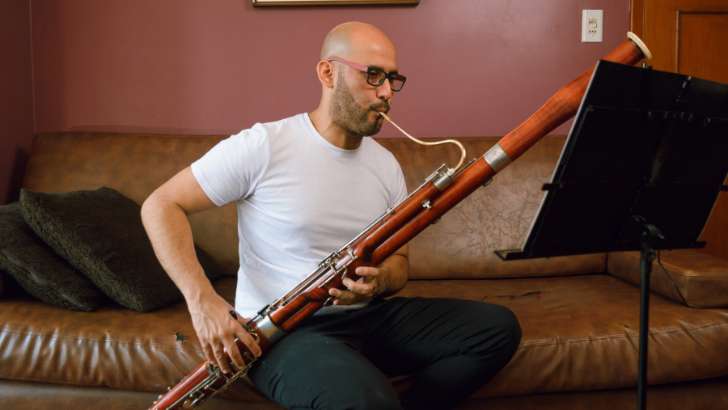
The bassoon is a unique and complex woodwind instrument crucial to the symphony orchestra’s sound palette. Physically, it stands out with its long, slender wooden body, which loops back on itself and ends in a distinctive metal bell.
It’s played using a double reed, which vibrates to produce sound when air is blown into it. The bassoon is traditionally made from maple wood and has intricate silver or nickel keys that control the pitch.
The bassoon produces a rich, deep voice, often described as warm and reedy. Its tones can convey everything from melancholy to whimsy, making it a versatile instrument in orchestral settings.
Originally developed in the 16th century in Italy, the bassoon has evolved significantly over the centuries.
In the orchestra, the bassoon often handles bass and tenor lines, supporting harmonies or crafting distinctive, melodic undercurrents.
Famous composers like Mozart and Stravinsky have showcased the bassoon in their works, using its full tonal range to enrich their compositions. Notable bassoonists like Klaus Thunemann and Loren Glickman have also championed this instrument, bringing its sounds to audiences worldwide.
Piccolo
Essentially a smaller flute, it plays an octave higher, adding sparkle and brilliance to the higher registers.
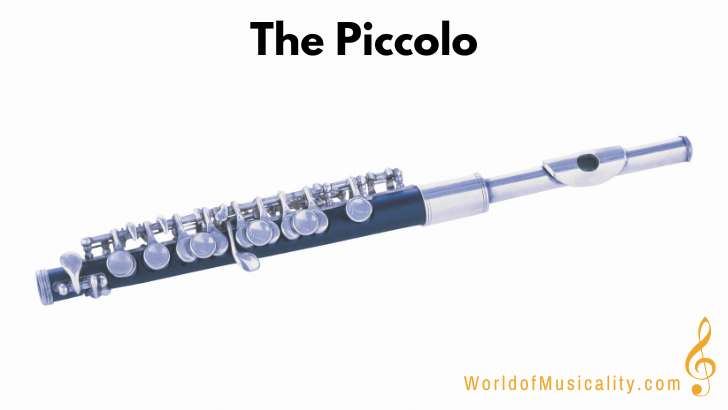
The piccolo is a small flute and is technically classified as a woodwind instrument, though it is often made from metal, wood, or a combination of both. Its body consists of three parts: the head, body, and foot.
It has a series of holes covered by keys, which the player opens and closes to change the pitch. The piccolo produces a high-pitched, bright, and penetrating sound, which can cut through the sound of an entire orchestra, making it ideal for adding sparkling accents and airy effects to the music.
Originating from the Baroque period, the piccolo adds an energetic layer to orchestral compositions. It often plays an octave higher than written, giving it a unique presence in orchestral scores.
Notable composers like Vivaldi and Beethoven have utilized the piccolo to enhance their compositions. One significant piece to hear the piccolo in action is Beethoven’s Symphony No. 9, where it plays a crucial role in the final movements.
Brass Instruments of the Symphony Orchestra
Brass instruments provide power and drama and are often used in climactic and bold passages within orchestral music.
Trumpet
Produces a bright, powerful sound and is often featured in bold, climactic parts of the music.
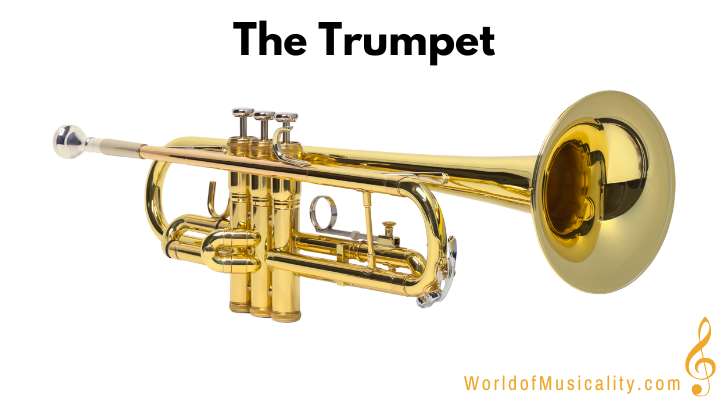
The trumpet, a prominent brass instrument in the symphony orchestra, is crafted mainly from brass and is known for its bright, powerful sound. Physically, it features a flared bell, a mouthpiece, and three valves which the player presses to change the pitch. Its sound can range from bold and commanding to warm and mellow, making it versatile in orchestral settings.
The trumpet has roots in ancient civilizations but evolved into its current form in the early 19th century with the invention of valves. In an orchestra, the trumpet plays a crucial role in adding dramatic flair and leading triumphant passages, often standing out during climactic moments.
Notable composers who have extensively featured the trumpet in their compositions include Johann Sebastian Bach and Wolfgang Amadeus Mozart. Additionally, modern listeners might recognize the skills of Maurice André, a celebrated trumpet virtuoso known for his exquisite control and range.
Flugelhorn
Similar to a trumpet but with a wider, softer sound, often used in jazz and brass band music.
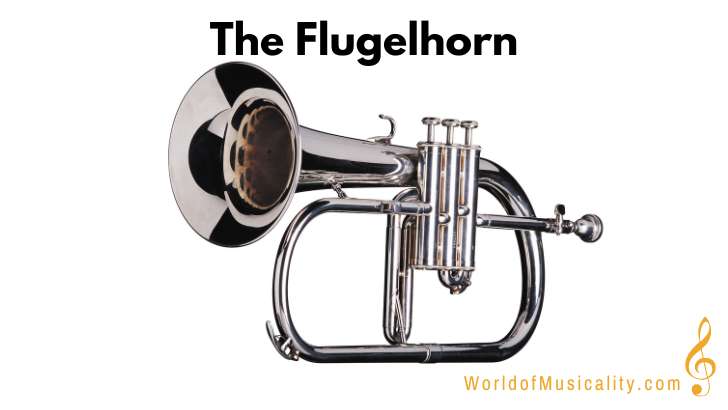
The flugelhorn is a brass instrument resembling a trumpet but with a wider, conical bore that gives it a softer, mellower sound. It features a mouthpiece through which the player blows, three valves that the player presses to change the pitch, and a bell where the sound emanates.
The main materials used to construct the flugelhorn are brass for the body and occasionally silver or gold plating for a richer tone.
Originally developed in Germany in the early 19th century, the flugelhorn was first used in military bands before transitioning into both jazz and classical music.
While not as common in the symphony orchestra as other brass instruments like the trumpet or trombone, when the flugelhorn is included, it adds a rich, warm timbre to the brass section. It’s particularly valued in softer, more lyrical passages.
Noteworthy classical musicians specifically famous for playing the flugelhorn are rare, as it is more prominent in jazz settings, but its use in classical compositions occasionally highlights its unique sound within orchestral works.
French Horn
Known for its warm, mellow tone, the French horn can play both melody and harmony and is indispensable in the orchestra.
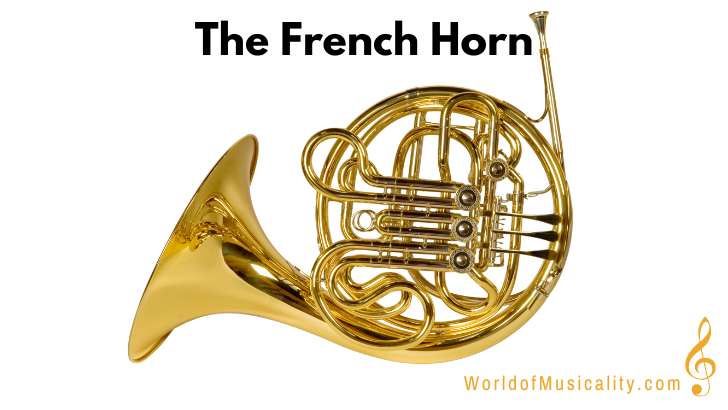
The French Horn is a distinct instrument in the symphony orchestra, instantly recognizable by its large, circular body of coiled tubing ending in a wide bell. It is constructed mainly from brass, which contributes to its rich, warm sound. When played, the French Horn produces a deep, resonant tone that can range from soft and mellow to loud and heroic, making it extremely versatile.
Its sound is often described as smooth and velvety, capable of blending well with both woodwinds and other brass instruments.
Originating from hunting horns, the modern French Horn was developed in the 17th century in France. In the orchestra, it plays a crucial role in creating harmonic and melodic textures, often used to convey a sense of emotion and drama.
Famous composers like Richard Wagner have written extensively for the French Horn, showcasing its capabilities in solo and ensemble settings. Renowned horn players like Dennis Brain and Barry Tuckwell have also demonstrated the instrument’s expressive range through their performances.
Trombone
Unique with its sliding mechanism, the trombone provides a wide range of dynamics and tones, from powerful blasts to soft melodies.
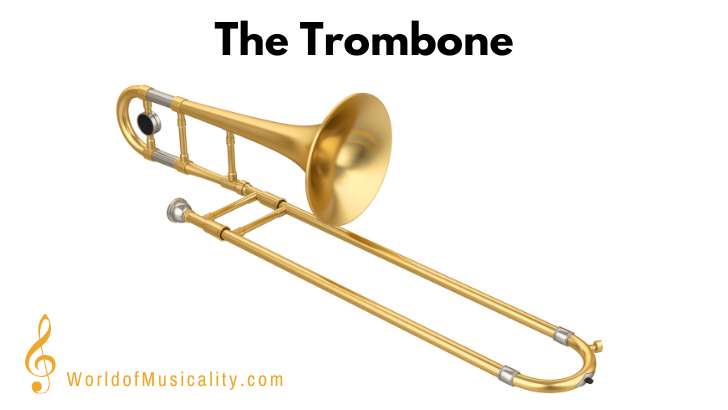
The trombone is a distinctive brass instrument recognized for its sliding mechanism, which distinguishes it from other members of the brass family that typically use valves. This slide allows the trombonist to smoothly adjust the length of the air column inside the tube, altering the pitch to produce a wide range of notes.
Physically, the trombone consists of a long metal tube that loops back on itself, ending in a large bell that projects the sound. Most trombones are made from brass, but some may have components crafted from nickel or other metals for added durability or tonal quality.
The trombone produces a rich, full sound that can vary from powerful and commanding to soft and mellow. It has a vital role in the symphony orchestra, adding depth to the brass section and often playing harmonies or bold, clear melodies.
Originating in the 15th century, the trombone has a strong presence in classical music. Notable composers like Wolfgang Amadeus Mozart and Ludwig van Beethoven utilized the trombone for its dramatic effect, particularly in their symphonies and operas. Among the celebrated trombonists to explore would be Christian Lindberg, known for his virtuosic performances and contributions to expanding the trombone repertoire.
Cornets
Brass instruments similar to the trumpet but with a more mellow tone, commonly featured in concert bands.
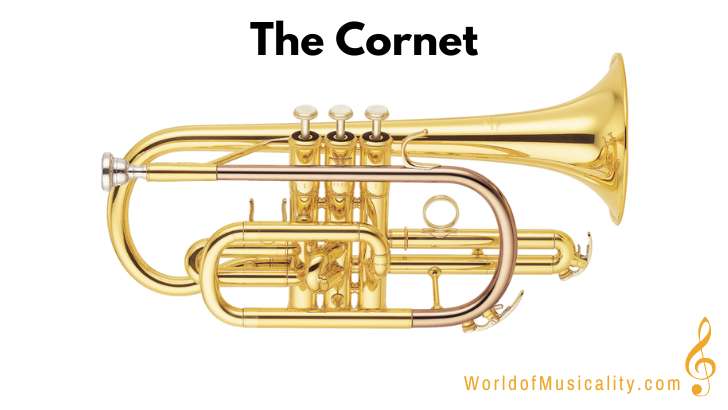
The cornet is a brass instrument that closely resembles the trumpet but has a more compact shape and a mellower tone. It is made primarily of brass and features a conical bore, which gradually widens from the mouthpiece to the bell. This design gives the cornet a softer, more rounded sound compared to the trumpet’s bright, piercing quality.
The cornet emerged in the 19th century and was initially used in military bands before becoming popular in orchestral and classical music settings. In the context of a symphony orchestra, the cornet occasionally supplements or replaces the trumpet, adding a lush, warm timbre that blends smoothly with other brass instruments.
Significant musicians in the classical realm who have been known for their cornet playing are less common than those for other brass instruments, but composers like Gustav Mahler and Nikolai Rimsky-Korsakov have utilized the cornet for its unique sound in their orchestral works, particularly in solos that require a gentle, lyrical quality.
Tuba
The largest brass instrument with the lowest pitch, providing the foundational bass in the brass family.
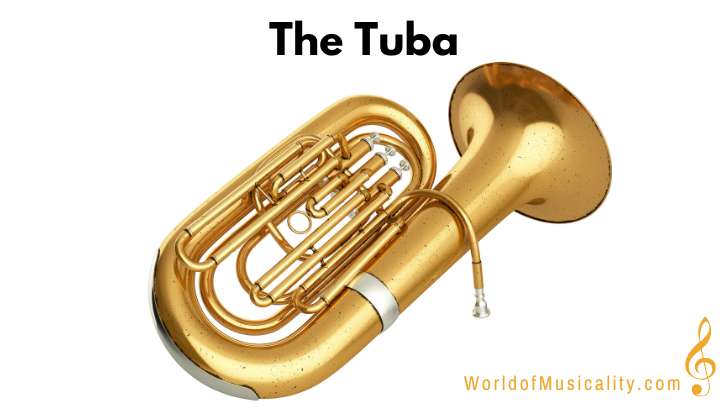
The tuba is the largest brass instrument in the symphony orchestra, known for its deep, resonant sound that often serves as the foundation for the brass section.
Constructed mainly from brass, the tuba is a long, winding tube ending in a large bell that amplifies its sound. Players produce notes by buzzing their lips against a large mouthpiece, manipulating pitches with valves that change the tube’s length.
The tuba which was developed in the mid-19th century, was designed to add a lower range to the brass family.
Its role in the orchestra is typically to support harmony and rhythm, laying a robust bass line that other instruments build upon. In symphonic compositions, the tuba is less frequently featured as a solo instrument, but when it is, the effect can be powerful and moving.
Significant composers who have written memorable parts for the tuba include Richard Wagner and Richard Strauss, whose orchestral works exploit the tuba’s majestic and bombastic qualities. Listening to pieces like Wagner’s “Ride of the Valkyries” or Strauss’s “Also sprach Zarathustra” can showcase the tuba’s dynamic capabilities within the orchestra.
Saxophone
A woodwind instrument made of brass, known for its rich, expressive sounds in orchestral and jazz contexts.
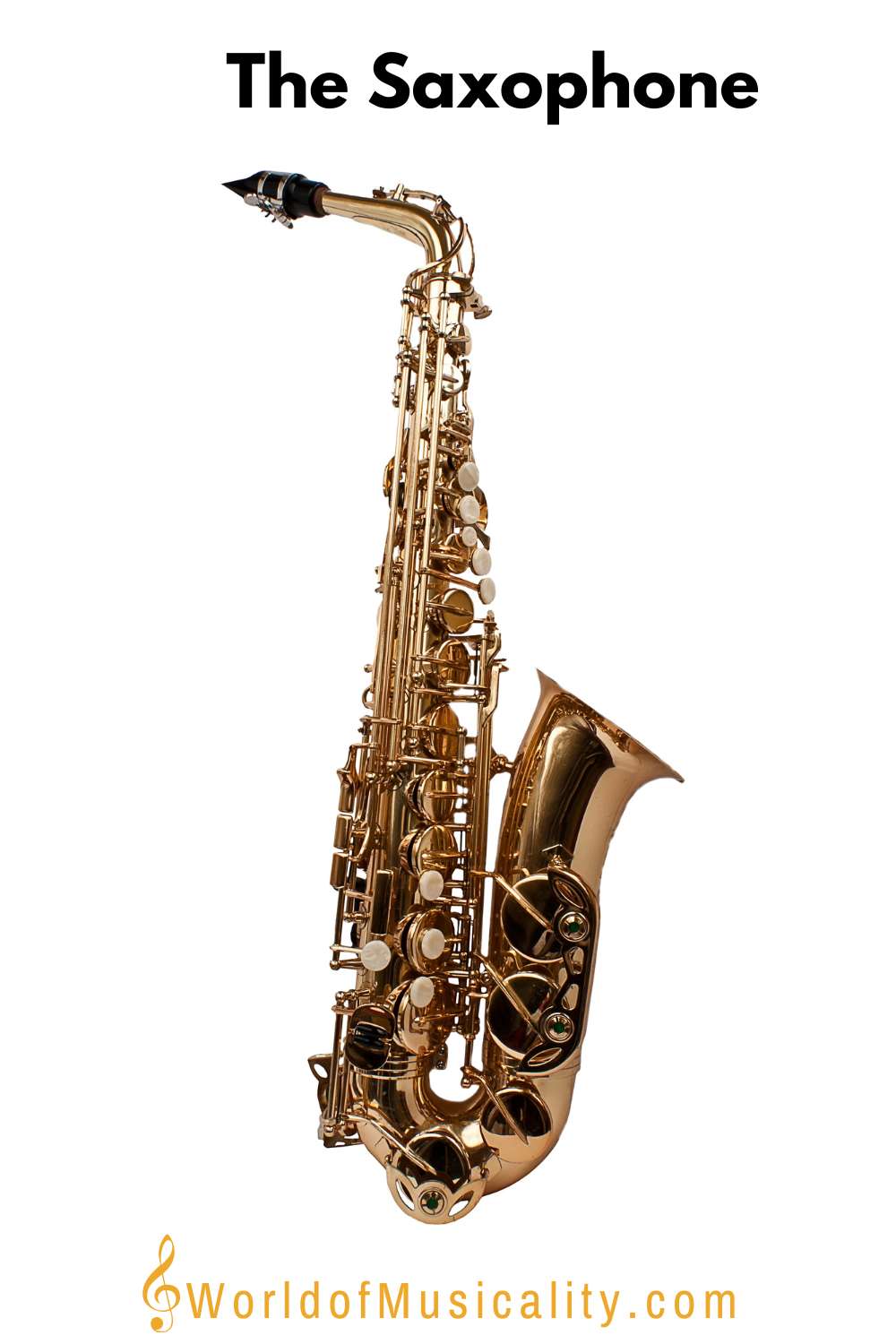
The saxophone is a unique woodwind instrument made primarily of brass, which contributes to its distinctive, resonant sound. It has a curved shape, ending in a flared bell, and uses a single-reed mouthpiece similar to that of a clarinet. Players produce sound by blowing into the mouthpiece, causing the reed to vibrate and send air through the instrument’s body, creating notes.
The saxophone was invented in the 1840s in Belgium by Adolphe Sax, a musical instrument designer. Though originally developed for use in military bands, its expressive range has found an increasing presence in orchestral and classical music, albeit more sparingly compared to other woodwinds due to its modern origins.
In the context of the symphony orchestra, the saxophone is often featured in specific pieces that require its warm, versatile tone, such as Maurice Ravel’s “Boléro” and some works by Dmitri Shostakovich. Renowned classical saxophonists like Marcel Mule and Sigurd Raschèr have helped popularize the saxophone in classical music, contributing significantly to its repertoire and acceptance in classical settings.
Percussion Instruments
Percussion instruments offer rhythm and color, punctuating the music with dynamic accents and effects.
Piano
A large keyboard instrument whose strings are struck by hammers. Often miscategorised as a string instrument.
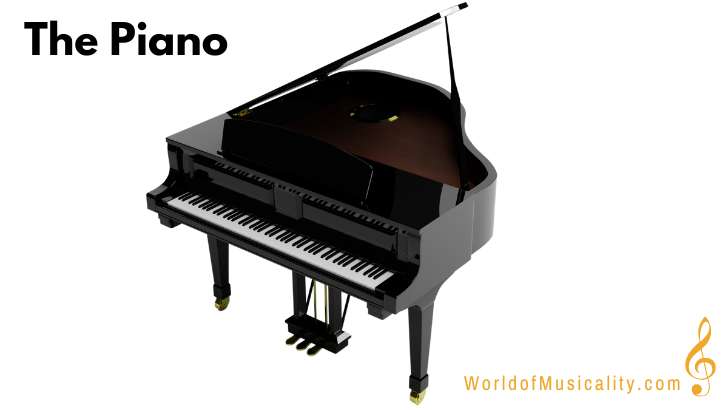
The piano is a fascinating instrument that combines aspects of string and percussion mechanics. It’s constructed primarily from wood for the frame and soundboard, with steel for the strings and often cast iron for the harp-shaped plate that withstands the string tension.
When you press a piano key, it activates a small hammer inside the instrument that strikes the strings, producing sound. This action classifies the piano as a percussion instrument, despite having strings, because sound is generated through striking.
The piano’s sounds range from deep, resonant bass notes to clear, high pitches, making it incredibly versatile in an orchestral setting.
Originally developed in the early 18th century from earlier keyboard instruments like the harpsichord, the piano quickly became fundamental in both solo and ensemble settings.
In a symphony orchestra, the piano isn’t typically a standard member but is featured in specific compositions called “concertos,” where it plays a central, soloistic role.
Significant composers who have elevated the piano include Ludwig van Beethoven and Frédéric Chopin, both of whom composed profoundly innovative works that are essential listening for anyone exploring this instrument’s capabilities.
Celesta
A keyboard instrument with a gentle, bell-like sound, famously used in Tchaikovsky’s “Dance of the Sugar Plum Fairy.”
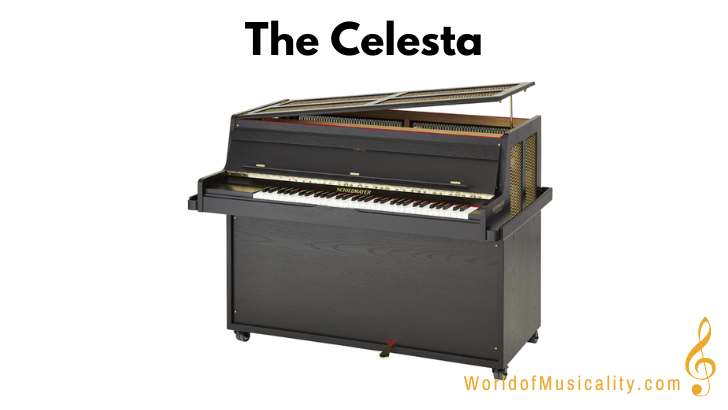
The celesta is a unique keyboard instrument that looks somewhat like a small upright piano. It produces sound through metal plates or bars struck by felt hammers that are triggered when the keys are pressed. These metal plates are typically made of steel, and the resonators beneath them are usually crafted from wood, enhancing the instrument’s delicate, bell-like sound.
Its role in the symphony orchestra, though not as prominent as other instruments, is irreplaceable when it comes to creating specific, celestial atmospheres in music.
Developed in Paris in the late 19th century by Auguste Mustel, the celesta quickly became a favorite in orchestral music for its ability to add a magical sound texture, perfectly suited for atmospheric and mystical effects.
It is famously used in Tchaikovsky’s “Dance of the Sugar Plum Fairy” from The Nutcracker, highlighting its ability to bring a dreamy quality to compositions.
Notable composers like Gustav Mahler and Claude Debussy have also utilized the celesta’s unique sound in their symphonic works, making it an essential instrument in the classical and orchestral repertoire.
Timpani
Also known as kettledrums, these are tuned to specific pitches and provide rhythmic and harmonic support.
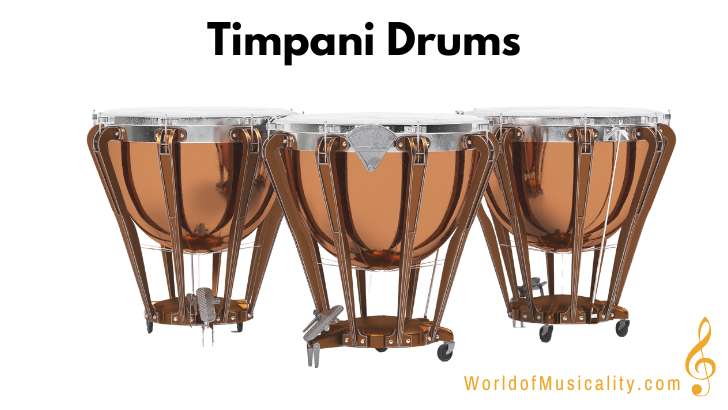
The timpani, also known as kettledrums, are an essential percussion instrument in a symphony orchestra. Constructed from large copper bowls with a tightly stretched calfskin or synthetic drumhead on top, they are played with special mallets.
The timpani produce a deep, resonant sound that can vary in pitch. By using a pedal mechanism, players can adjust the tension on the drumhead, thereby changing the pitch to produce different musical notes.
Originating from military drums in ancient times, the timpani have been part of the orchestral ensemble since the 17th century, adding dramatic depth and emphasis to musical compositions. They often underline the rhythm and can lead dynamic changes within a piece, making them pivotal during climactic moments.
Significant composers who have prominently featured the timpani include Ludwig van Beethoven and Gustav Mahler, whose symphonies exploit the instrument’s dynamic and tonal capabilities. When listening to orchestral music, the powerful beats of the timpani are not just heard; they are felt, enhancing the emotional impact of the orchestral performance.
Snare Drum
Known for its sharp, staccato sound, the snare drum adds rhythm and drama to the orchestra.
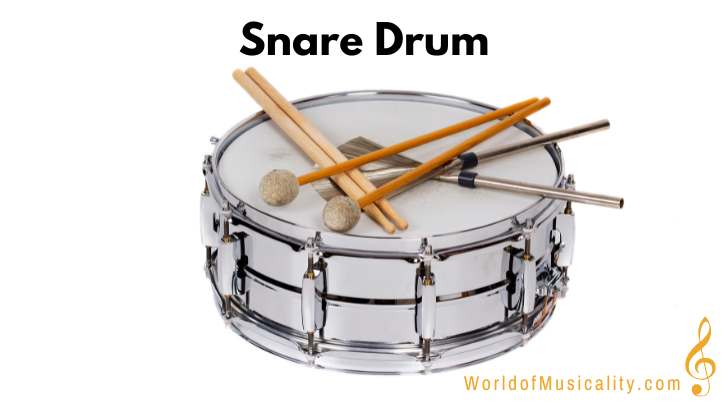
The snare drum is a vital percussion instrument found in symphony orchestras and many other musical genres. Physically, it resembles a shallow cylinder with a drumhead on both the top and bottom. It’s typically made from materials like wood or metal for the body and plastic or animal skin for the drumheads.
The unique “snare” effect comes from metal wires stretched across the bottom drumhead, which rattle when the top head is struck, producing a sharp, crisp sound that cuts through the orchestra.
Originating from medieval Europe, where it was used in military and ceremonial music, the snare drum has evolved into a crucial element of orchestral compositions. In the orchestra, it often provides rhythm and enhances dramatic passages, adding tension or excitement to the music.
While there are no specific composers or musicians exclusively associated with the snare drum, it features prominently in the works of composers like Ludwig van Beethoven and Igor Stravinsky, who utilized its distinctive sound to heighten the impact of their music.
Bass Drum
Produces deep, thunderous sounds and is used for emphasizing the rhythm or creating dramatic effects.
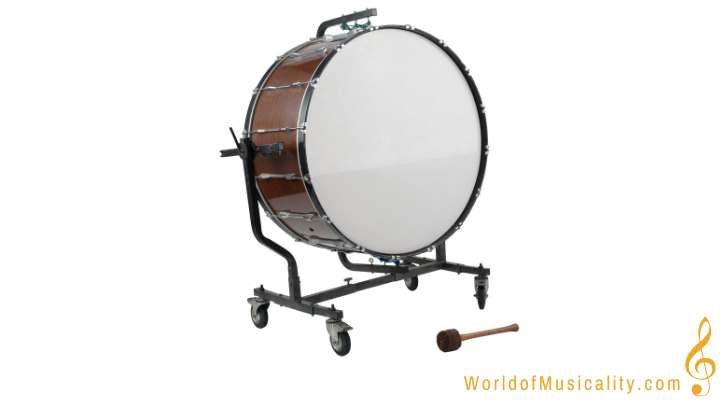
The orchestral bass drum is known for its deep, resonant and booming sound.
It is constructed primarily from a large, cylindrical shell often made of wood, such as maple or birch, which helps to produce its profound booming sound.
Both sides of the drum are covered with a synthetic material or animal skin, called drumheads, which are struck with mallets to create sound.
Originating from various cultures and used in military and ceremonial music, the bass drum was incorporated into the orchestra to add power and depth to musical compositions.
In an orchestra, its role is to emphasize the rhythm and add dramatic effects during climactic moments, supporting the overall dynamics of the performance.
The bass drum is featured prominently in works by composers like Gustav Mahler and Richard Wagner, who utilized its grandeur to enhance their orchestral compositions.
Cymbals
Typically crashed together to create a loud, crashing sound or played individually for lighter effects.
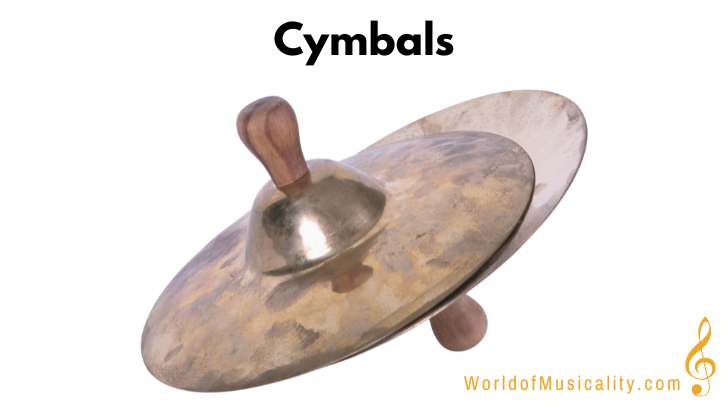
The cymbals, used in a symphony orchestra, are round, concave brass plates that clash together to create a loud, crashing sound.
Made primarily from an alloy of copper and tin, these instruments vary in size, which influences their pitch and volume. The sound of cymbals is vibrant and resonant, used primarily to accentuate peaks in musical passages and to add drama during climactic moments.
Originating from ancient times, cymbals have been used in many cultures for both musical and ceremonial purposes.
In the symphony orchestra, they form a crucial part of the percussion section, adding a dynamic layer to compositions.
Notable composers like Gustav Mahler and Richard Wagner often featured cymbals in their orchestral works to enhance the emotional impact of their music.
Xylophone
A keyboard-like percussion instrument made of wooden bars, struck with mallets to produce a bright, resonant sound.
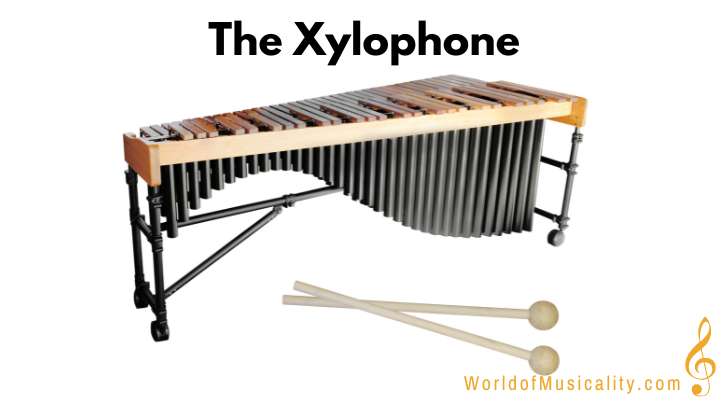
The xylophone is a percussion instrument made primarily of wooden bars of various lengths, each producing a different pitch when struck with mallets.
The bars are typically made from hardwoods like rosewood or synthetic materials that mimic wood’s resonant qualities. Underneath the bars, resonator tubes enhance the sound, making it richer and more vibrant.
This instrument has origins in Africa and Asia, but it has been adopted and adapted by Western classical music. In a symphony orchestra, the xylophone adds a bright, metallic sparkle to the sound palette, often used to emphasize rhythm or add a playful character to the music.
Notable compositions featuring the xylophone include Camille Saint-Saëns’ “Danse Macabre,” where it mimics the rattling of bones.
If you would like to learn more facts about the amazing world of musical instruments, visit our homepage at worldofmusiclality.com or click the links below to explore the rest of our site.




